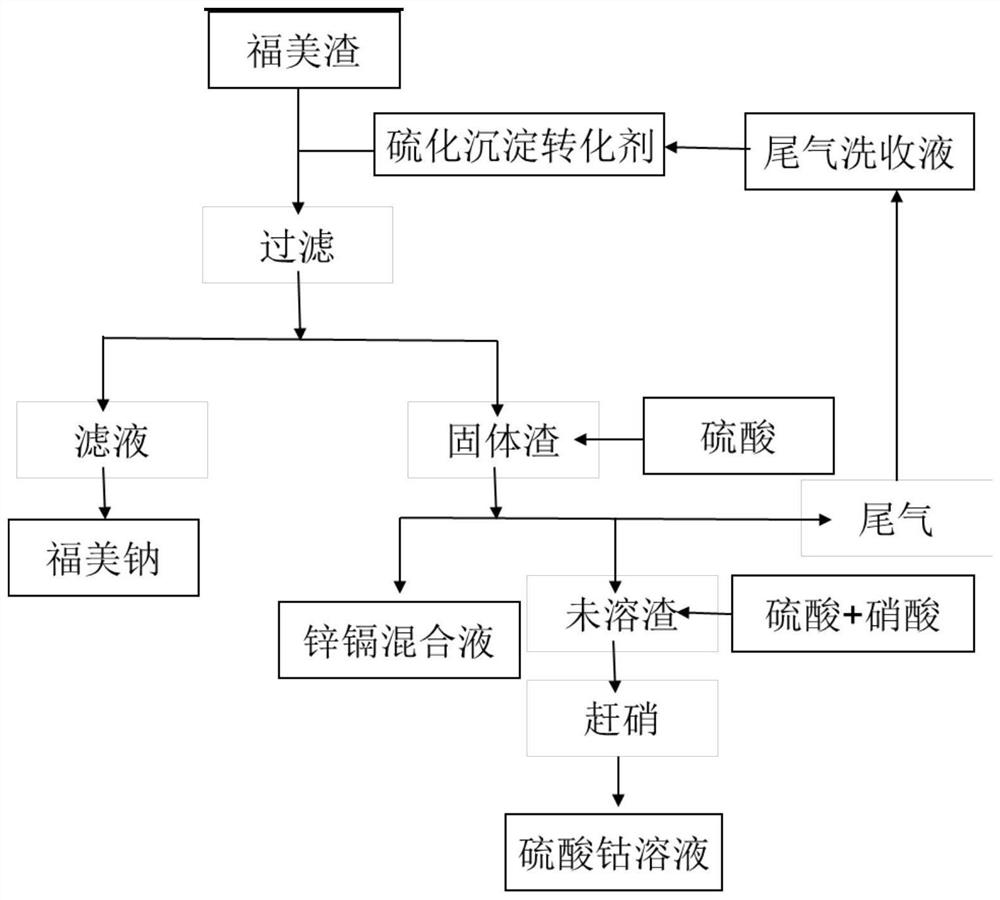A kind of recycling method of fumei slag
A technology of fumei slag and slag, which is applied in the improvement of process efficiency, organic chemistry, etc., to achieve the effect of increasing economic benefits
- Summary
- Abstract
- Description
- Claims
- Application Information
AI Technical Summary
Problems solved by technology
Method used
Image
Examples
Embodiment 1
[0031] In the present embodiment, the chemical composition analysis (unit: %) of Fumei slag sees the following table:
[0032]
[0033] For the Fumei slag whose chemical composition and content are shown in the above table, the following procedures are carried out. figure 1 Processing shown:
[0034] (1) Take 31.70 g of fume slag (the fome root contained is 15 g in terms of sodium fomelic acid dihydrate), beat with 100 mL of water, add 30.00 g of sodium sulfide nonahydrate, react at 85° C. for 2 hours, and filter. The filtrate is distilled under reduced pressure to dryness to obtain 7.1 g of sodium formate dihydrate, and the yield of organic matter formate is 47.3%, which can be reused in the purification and decobalt removal process of electrolytically producing metallic zinc. The filtered solid slag is processed in the following step (2).
[0035] (2) The solid residue was first leached with 150 mL of 100 g / L sulfuric acid to obtain a solution containing zinc, and the y...
Embodiment 2
[0038] In this embodiment, the Fumei slag is the Fumei slag in Example 1, that is, its chemical composition content is the same as that in Example 1.
[0039] The Fumei slag is carried out as follows figure 2 Processing shown:
[0040] (1) Take 31.70 g of fume slag (the fome root contained is 15 g in terms of sodium fomelic dihydrate), beat with 300 mL of water, add 24.00 g of sodium sulfide nonahydrate, react at 70° C. for 2 hours, and filter. The filtrate is distilled to dryness under reduced pressure to obtain 6.9 g of sodium formate dihydrate, and the yield of organic compound formate is 46%, which can be reused in the purification and removal of cobalt in the electrolytic production of metallic zinc. The filtered solid slag is processed in the following step (2).
[0041] (2) The solid slag was first beaten with 30mL water, and then 13.00g MnO 2 and 25mL of 6.00mol / L sulfuric acid at 70°C for 6 hours under normal pressure oxidative leaching to obtain a solution contai...
Embodiment 3
[0044] In this embodiment, the Fumei slag is the Fumei slag in Example 1, that is, its chemical composition content is the same as that in Example 1.
[0045] The treatment method of this Fumei slag is basically the same as Example 2, and the difference is:
[0046] In the step (1), the reaction temperature was 10° C. and the reaction time was 5 hours, to obtain 6.1 g of sodium formate dihydrate, and the yield of the organic compound formate was 40.67%.
[0047] In step (2), the solid slag used 35.00g Na 2 S 2 O 8 and 40.00 mL of 6.00 mol / L concentrated sulfuric acid at 70 °C for 6 h under normal pressure oxidative leaching to obtain a solution containing zinc and cadmium. The yields of zinc and cadmium are 89.1% and 88.7%, respectively.
[0048] In the step (3), the undissolved residue was subjected to suction filtration at 130° C. to obtain 1.6 g of sulfur. The residual slag was calcined in a muffle furnace at 600°C for 2 hours to obtain 0.91 g of cobalt tetroxide as a s...
PUM
 Login to View More
Login to View More Abstract
Description
Claims
Application Information
 Login to View More
Login to View More - R&D
- Intellectual Property
- Life Sciences
- Materials
- Tech Scout
- Unparalleled Data Quality
- Higher Quality Content
- 60% Fewer Hallucinations
Browse by: Latest US Patents, China's latest patents, Technical Efficacy Thesaurus, Application Domain, Technology Topic, Popular Technical Reports.
© 2025 PatSnap. All rights reserved.Legal|Privacy policy|Modern Slavery Act Transparency Statement|Sitemap|About US| Contact US: help@patsnap.com



